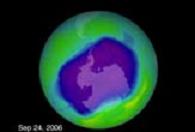Is humanity solely to blame for the hole in the ozone, or did the Montreal Convention prove that the hole in the ozone was caused not only by the fault of human activity

Apparently the answer is known and clear, the emission of sprays and chemicals such as chlorofluorocarbons (CFC), these bind to ozone in the stratosphere and break it down, the ozone layer as we know protects us and our environment by emitting ultraviolet radiation, radiation in high doses that harms and harms life and plants. In order to prevent the damage, the countries of the world committed to fulfill the terms of the Montreal Convention, a convention that requires stopping the production and emission of substances that damage the ozone layer.
So far everything is clear and known. We will only add that since the treaty came into effect (1987), the researchers expect to see the "hole" in the ozone layer shrink, every year towards the summer they report a "decrease in the area of the ozone "hole"" and towards the winter it turns out that the "hole" is growing again. So what's going on here? Why is there no immediate positive response to the cessation of the use and distribution of substances that harm the ozone?
It turns out that we are not the only ones to blame, chemicals/gases that originate from nature can cause damage to the ozone layer, according to a study done by NASA researchers and published in Geophysical Research Letters, nitrogen is one of the natural causes of damage to the ozone layer, when nitrogen reaches the stratosphere It becomes active with the help of sunlight and combines with oxygen (ozone) to form nitrogen oxide. The nitrogen that is usually found in the lower layers of the atmosphere reaches the stratosphere by air vortices created by strong winds. According to the findings, winds/eddies have a much greater effect than they thought. The study showed that due to the winds and the abundance of nitrogen in the stratosphere, the ozone layer was damaged to a level similar to the damage in 2004-2003 when "solar storms" "bombarded" the area and caused the nitrogen level to rise and the ozone level to be severely damaged.
The difference between the injury by C.P.C. and nitrogen can be distinguished since C.P.C. come from the ground and damage the lower part of the ozone layer, while the nitrogen damages the ozone in the upper part of the stratosphere, damage that according to the researchers does not cause an immediate risk (because of the location) but since the ozone layer heats up while absorbing ultraviolet radiation, and the heat is radiated to the ground, there may be another factor that affects on the global climate.
Although this is a natural factor, it is possible that the human activity that affects climate change is the one that causes stronger winds in Antarctica, winds that mix the air and raise the nitrogen into the stratosphere, meaning again, even though the cause seems natural, it turns out that human activity has a hand and foot in stimulating the process.
Various sources report (news for mornings) about the "shrinking of the hole in the ozone" It was reported that it is not accurate because the "hole is measured in its area but also in its depth, according to the report of the European Space Agency (ESA), the depth of the hole in the ozone broke all records, In total, the ozone layer lost forty million tons. According to the researchers' predictions, in 2018 the "hole" in the ozone will reach a size of about 25 million km, roughly the size of Africa, only in 2020 will the "hole" begin to "heal", and in 2070 the ozone layer will reach its normal level.
Despite announcements in the media about a decrease in the size of the "hole", the researchers predict that after checking the results it will become clear that 2006 was not a "good year".

4 תגובות
The problem in the world:
Why not think about creating some kind of layer that will be in place of the ozone? And stronger than him? Because as it is written, researchers thought that in 2006 the hole would shrink, and it didn't happen, so it's impossible to know if it will happen at all. You have to try to develop some layer that neither the CPC nor the nitrogen will be able to destroy. I wonder if the researchers have already tried this.
Write practical factors that we humans do on a daily basis without knowing that we are causing a hole in the ozone
Why do people need ozone?